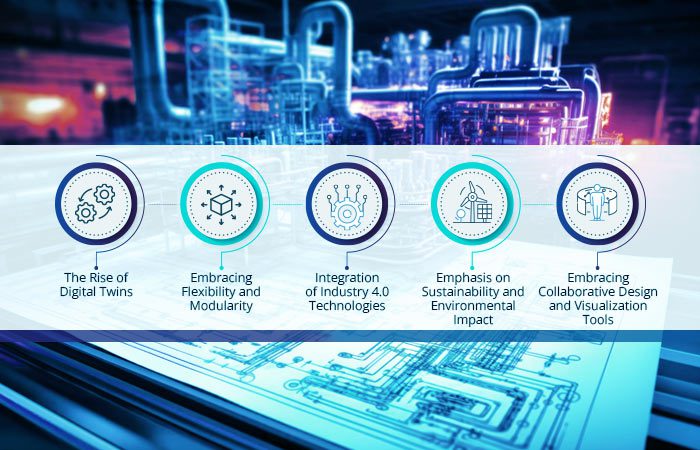
Exploring the Evolving Landscape of Plant Layout Engineering: 5 Key Trends
In the realm of industrial engineering, the intricacies of plant layout design wield a profound impact on efficiency, productivity, and safety within manufacturing facilities. As industries evolve and technology advances, so too do the trends in plant layout engineering.
In this blog, we delve into the latest innovations and approaches shaping the landscape of plant layout engineering.
- The Rise of Digital Twins
One of the most significant trends in plant layout engineering is the adoption of digital twin technology. Digital twins are virtual replicas of physical assets, processes, or systems. In the context of plant layout engineering, digital twins enable engineers to create highly accurate digital representations of manufacturing facilities.
By leveraging data from sensors, IoT devices, and other sources, digital twins provide real-time insights into equipment performance, energy usage, and material flows. This information empowers engineers to optimize plant layouts for maximum efficiency and productivity. Additionally, digital twins facilitate simulation and scenario analysis, allowing engineers to test different layout configurations and identify potential bottlenecks or issues before implementation.
- Embracing Flexibility and Modularity
In today’s fast-paced business environment, adaptability is key to success. As a result, plant layout engineering is increasingly focused on creating flexible and modular layouts that can easily accommodate changes in production demands or technology.
Modular design principles involve breaking down the manufacturing facility into standardized modules or units that can be easily reconfigured or expanded as needed. This approach allows companies to scale production capacity quickly and cost-effectively, reducing downtime and improving overall agility.
Furthermore, flexible manufacturing systems, such as reconfigurable production lines and agile work cells, enable companies to respond rapidly to changes in market demand or product specifications. By embracing flexibility and modularity, plant layout engineers are helping companies stay competitive in an ever-changing landscape.
- Integration of Industry 4.0 Technologies
The fourth industrial revolution, often referred to as Industry 4.0, is characterized by the integration of digital technologies into all aspects of manufacturing. Plant layout engineering is no exception, as Industry 4.0 technologies are revolutionizing the way manufacturing facilities are designed and operated.
Automation plays a central role in Industry 4.0, with technologies such as robotics, artificial intelligence, and advanced control systems driving unprecedented levels of efficiency and productivity. In plant layout engineering, automation enables the creation of smart factories capable of autonomous operation and real-time optimization.
Furthermore, the Internet of Things (IoT) is enabling seamless connectivity between machines, equipment, and systems within the manufacturing environment. This connectivity allows for the collection and analysis of vast amounts of data, empowering engineers to make data-driven decisions and optimize plant layouts for peak performance.
- Emphasis on Sustainability and Environmental Impact
In recent years, there has been a growing emphasis on sustainability and environmental responsibility in plant layout engineering. Companies are increasingly seeking to minimize their environmental footprint and reduce energy consumption and waste in their manufacturing operations.
One approach to achieving these goals is through green design principles, which involve incorporating sustainable materials, energy-efficient systems, and renewable energy sources into plant layouts. For example, engineers may design facilities to maximize natural light and ventilation, or integrate renewable energy technologies such as solar panels or wind turbines.
Additionally, optimizing material flows and minimizing waste generation are key priorities in sustainable plant layout engineering. By designing layouts that minimize the distance materials travel and reduce the need for excess inventory storage, engineers can help companies minimize their environmental impact while improving operational efficiency.
- Embracing Collaborative Design and Visualization Tools
Collaboration and visualization tools are playing an increasingly important role in plant layout engineering, enabling multidisciplinary teams to collaborate effectively and iterate on design concepts in real-time.
Advanced CAD (Computer-Aided Design) software allows engineers to create detailed 3D models of manufacturing facilities, providing stakeholders with a clear understanding of proposed layout configurations. Virtual reality (VR) and augmented reality (AR) technologies take this a step further, allowing users to immerse themselves in virtual environments and experience proposed layouts firsthand.
By embracing collaborative design and visualization tools, plant layout engineers can facilitate better communication and decision-making among project stakeholders, ultimately leading to more efficient and effective plant layouts.
Plant layout engineering is undergoing a period of rapid evolution, driven by advances in technology, changing business dynamics, and growing emphasis on sustainability. From the rise of digital twins and Industry 4.0 technologies to the embrace of flexibility and sustainability principles, the latest trends in plant layout engineering are reshaping the way manufacturing facilities are designed and operated.
By staying abreast of these trends and embracing innovative approaches, plant layout engineers can help companies achieve greater efficiency, productivity, and sustainability in their manufacturing operations, positioning them for success in an increasingly competitive global marketplace.

